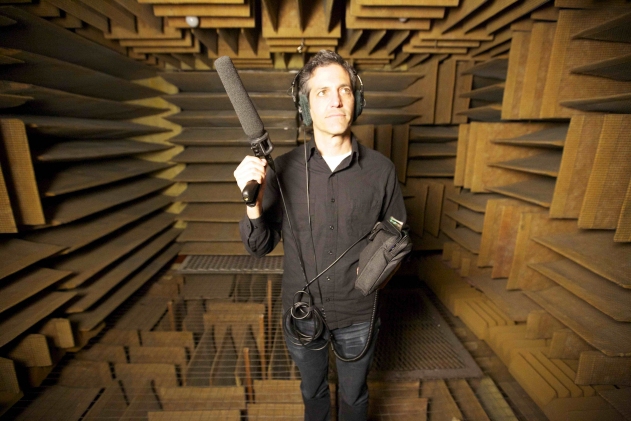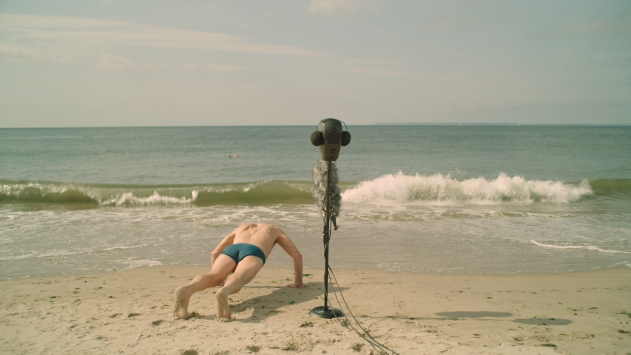
Academy Award-nominated filmmaker Sam Green (THE WEATHER UNDERGROUND), known for his live cinema performances, has translated his newest work 32 SOUNDS into a film that opening theatrically at Film Forum on April 28, with a national rollout to follow. 32 SOUNDS focuses on the sonic elements of the environments through which it moves—from archival recordings, to the work of a foley artist, through the history of experimental music featuring such composers as John Cage and Annea Lockwood, historical anecdotes, and personal reflection. During the live performance, which Green does together with composer JD Samson, audience members are given headphones. Some of the screenings at Film Forum will also have live audio mixing and headphones provided. We spoke with Green from his studio in Brooklyn about the challenges of making a film about sound, his entry points, and the significance of 32.
Science & Film: What kind of audience were you imagining when you started making this work–was it a general audience?
Sam Green: I generally make movies that I would want to see, that's sort of my guide, and my tastes are pretty poppy. So, without being deliberate about it, my work is accessible. The form of live cinema that I do is generally conversational. I'm just being myself, I'm a Midwestern person, you know, like a nice, Midwestern person, and so I think the work has that spirit in it. I'm not somebody who makes work just for my own edification or makes work that is primarily challenging. I want to make work that people will engage with. I once saw Brian Eno talk, and he said something, it was great, I can't remember the exact quote, but it was like, I try to make work that people will love. I think there's a difference between that and pandering–I'm not pandering, but I am trying to make things that I would want to see.
S&F: How have you approached translating that tone from live cinema into the film itself?
SG: I've made many different live cinema pieces, and people have often said: are you going to make a regular movie out of it? It has never seemed to be something that could work. This has been the first time that a live cinema piece I made seems like it can work as a regular film, but they're so different, even though all the words are the same, and all the music is the same, and all the images are the same. It's so different as an experience.

Director Sam Green stands with recording equipment in an anechoic chamber. Photo credit: Free History Project.
One of the things I love about live cinema is that there's that extra layer of magic that comes from people all being together in a room. But one of the challenges is people are constantly saying, I missed that, when can I see it? So this is actually great, because I'll be like: you can stream it–eventually. Each of the ways in which people see things these days is different. I have a friend who is somebody who I really respect as a filmmaker who said to me, I'm watching all movies on my phone now. And I was totally taken aback and mortified. I said: are you kidding me? And he said: No, I have headphones, and I lie in bed and put the phone right there [on my chest], and it's like an IMAX movie. And I thought, yeah, that's a great form.
With audio, there's a huge challenge: In the live show, we travel with headphones, and that's a way to control the sonic experience and use binaural effects. Figuring out how to do it in a theater with speakers was a huge job, and it works. It's better in some sections, and it's not as good in some sections. But generally, it's great. You have to make little tradeoffs, which is a technical conversation that for me, several years ago, my eyes would have glazed over. But now I'm a super nerd about sound.
S&F: Is there a way you also tried to control the sound experience for people who will watch at home?
SG: Making films, you have to be kind of a controlling person; you're trying to make this very carefully constructed experience for people and the idea that they could be reading their email at the same time, like, fuck that... it's like, you have to give up some control, but there's also like a desperate attempt to keep control. So, the film has small participatory prompts and in a way that's a ploy to control people's experience more.
I've thought so much about sound in the context of cinema and how they work together. Somebody, I can't remember who, said once that you can pretty much only focus on one sentence at a time. And if you're watching [a film], you're listening and hearing obviously, but you can't focus on it. My film asks you to close your eyes. I made a short film about Annea Lockwood about three years ago and came up with that as an idea to try to get people to listen. Those are fun, creative challenges.
S&F: Sound is such a big topic and your film has many entry points into the subject. What was yours originally?
SG: After making a movie about the Kronos Quartet, I was very interested in listening and sound. I learned all about the Avant Garde composers like John Cage, and people who thought a lot about sound. And then, when the pandemic happened, all the screenings I had were canceled. I was just at home, and I read a book about Pauline Oliveros. There was a line about her longtime friend Annea Lockwood who had recorded the sound of rivers for 50 years. That just really intrigued me, and I had never heard of Annea Lockwood. I started Googling her. She has a song called "Tiger Balm." It's this great sort of collage of a cat purring and a jet going overhead and bells and somebody's having an orgasm. I think she made it in 1970 or something. When the pandemic happened, in the early months, I was working in a little studio in the backyard and I had at that point a four-year-old kid, and he would come out, I'd be working, and I'd be playing "Tiger Balm," and he was completely enchanted by it—he would just sit and listen to it many times. I realized, wow, this song has a kind of magic to it. And talk about accessible, if my four-year-old is into this Avant Garde music. So that got me curious, and I wrote to an Annea Lockwood, and I said: Hey, I'm just curious person, could I talk to you on Skype? And she wrote back and said: Sure, how about today? We started having a long conversation over many months. That was the impetus [for the film] because she's so thoughtful and smart about sound, and through her I went to a lot of places doing research. She's a great muse.
When we first started talking, I was like: Are you having a moment? Because she really is. And she said: Well, I've never been asked to talk as much as I am now. [laughs] I thought that was awesome.

Film still. An unidentified man does push ups at the water’s edge at Brighton Beach next to a binaural microphone. Photo credit: 32 SOUNDS.
S&F: I want to ask about the form—why 32 sounds?
SG: I love modular, episodic films. I love CAMERA PERSON a lot, Kirsten Johnson's movie. And I love THE HOTTEST AUGUST by Brett Story. I worked with Nels Bangerter the editor because he had edited both of those and I thought oh, he's smart about modular things. 32 came from the film THIRTY TWO SHORT FILMS ABOUT GLENN GOULD, which is one of my favorite movies. It's such a smart movie and smart in the context of biopics, which are in my mind the worst, most boring form because they follow tropes. Ninety percent of them start with a scene: the Johnny Cash movie, he's at San Quentin in Folsom State Prison, he's about to go on, and then it's a flashback, and it goes all the way through his life. And then it's back at that moment, and then it's over. And it's just like, ugh. I love THIRTY TWO SHORT FILMS ABOUT GLENN GOULD because it is in bits and pieces, and there's animation and documentary and actors. You never quite know where you're going and what it is. That's such a rare delight in film. It acknowledges there's no way to reduce a complex life—most people's lives are complex, Glenn Gould, especially—to a three-act structure and traditional forms of narrative. I thought with sound, there's no way to make the authoritative film about sound, all I can do is something in bits and pieces that is radically subjective. And that's what it is.
I also liked that THIRTY TWO SHORT FILMS ABOUT GLENN GOULD came from “The Goldberg Variations,” which is a famous piece of music that has 32 sections which was Glenn Gould's signature piece of music. So, they were referring to something else and I'm alluding to that so it's the sort of chain of illusions. That's 32 SOUNDS.
S&F: Do you have any sense of how sound will figure into your future work?
SG: I learned so much about sound and it makes me realize I knew almost nothing about sound as a filmmaker before. I think documentary is very rudimentary about sound. Gaming and VR are way more sophisticated about sound. Now I've learned enough to at least know I didn't know anything. Going forward, I will certainly be a much more thoughtful filmmaker about sound.
As if making a movie about sound wasn't hard enough—a movie with no main character, no conflict, no celebrity—I'm making something even harder now. I'm making a movie about trees, which I'm super excited about. I love trees, and I think somebody can make a great movie [about them]. I don't know how to, but I hope to figure it out. Trees and sound there's a lot there, and I certainly will embrace the sonic with this film.
S&F: Trees are also having a moment.
SG: Trees are totally having a moment in books. I don't know if anybody's making a film about trees, probably because it's super hard. I've been wanting to make a movie about trees for 15 years. I've just kept telling myself, someday I'll be old enough and wise enough to know how to do it. And still I am not, but I just thought, I'm gonna do it anyway.
♦
TOPICS